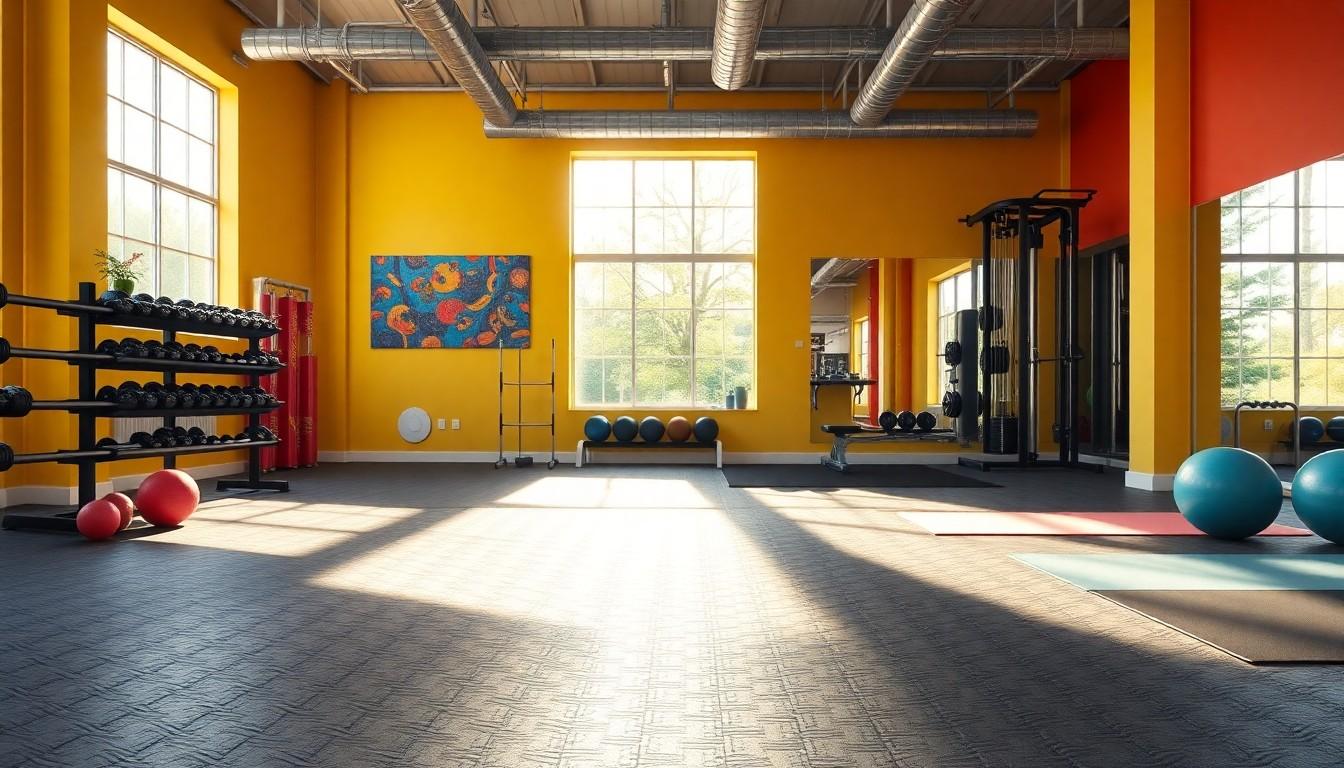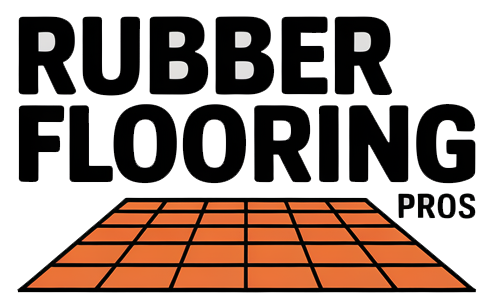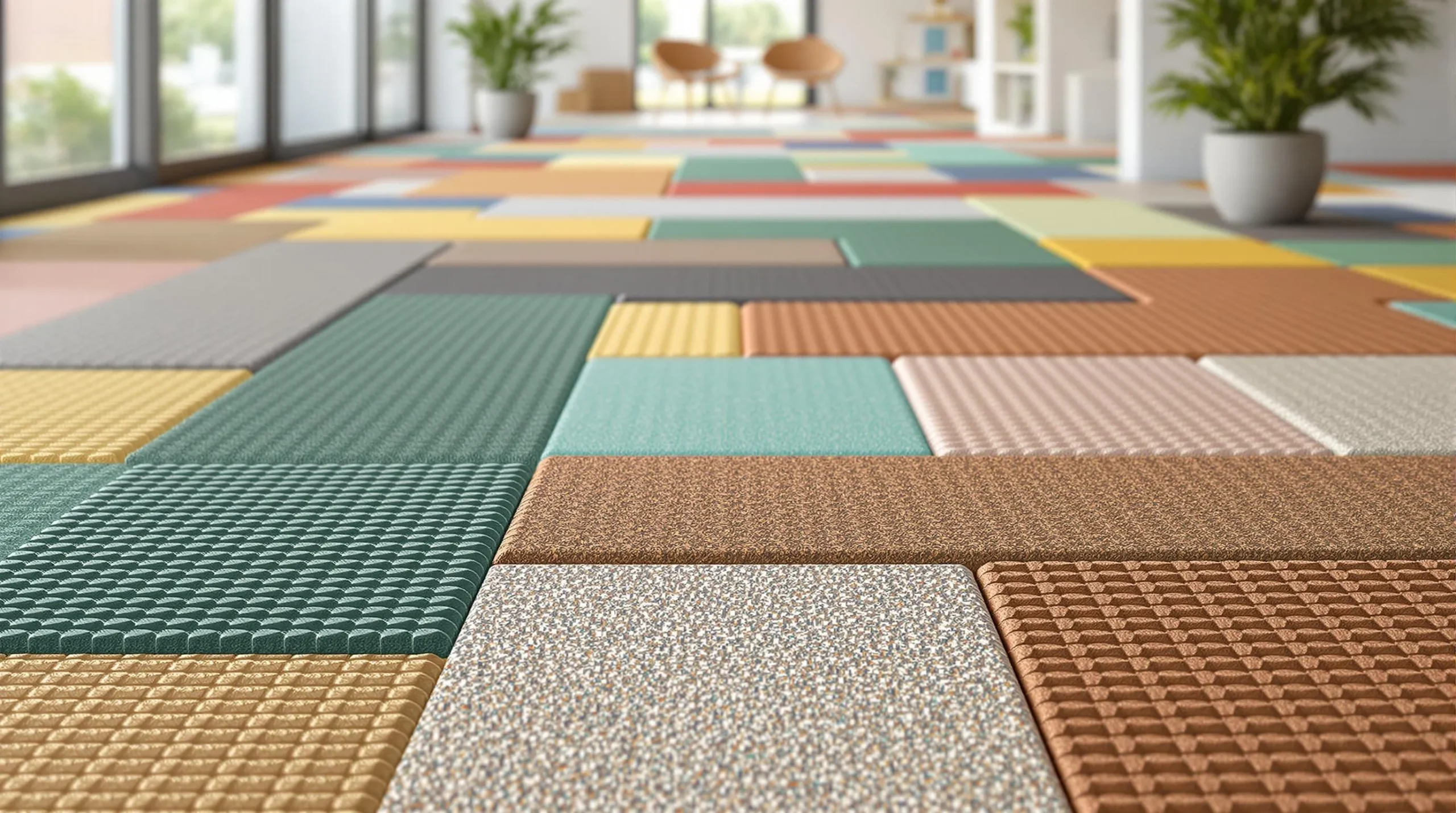Looking to transform your space with durable yet comfortable flooring? Rubber flooring has emerged as a versatile solution that’s taking both commercial and residential spaces by storm. From gyms and playrooms to modern offices you’ll find this resilient material making its mark in contemporary interior design.
Whether you’re renovating your home gym or seeking practical flooring for your children’s playroom rubber flooring offers an impressive blend of comfort safety and style. It’s a synthetic or natural material that comes in various forms including tiles rolls and interlocking mats making it adaptable to virtually any space. The growing popularity of rubber flooring stems from its unique combination of shock absorption slip resistance and easy maintenance features that traditional flooring materials often struggle to match.
Key Takeaways
- Rubber flooring is a versatile material made from natural or synthetic rubber, available in tiles, rolls, and interlocking mats, offering excellent durability and comfort
- The manufacturing process involves five key stages: material preparation, compression moulding, vulcanisation, quality control, and surface finishing, ensuring consistent quality
- Major benefits include exceptional durability (15-20 years lifespan), impact resistance, sound absorption (18-22 decibels reduction), and superior comfort compared to traditional flooring
- Ideal applications range from commercial spaces (gyms, medical facilities) to residential areas (home gyms, playrooms), with load capacities up to 500kg in commercial settings
- Installation can be professional (£8-15/m²) or DIY, with proper maintenance requiring daily cleaning and weekly deep cleaning using pH-neutral products
- Cost-effective long-term investment with prices ranging from £25-85/m², offering significant ROI through energy savings, reduced maintenance costs, and improved safety features
What Is Rubber Flooring and How Is It Made
Rubber flooring consists of processed rubber materials formed into durable surfaces for residential and commercial use. It’s manufactured through specific processes that transform raw rubber compounds into resilient flooring products.
Natural vs Synthetic Rubber Materials
Natural rubber flooring originates from latex extracted from rubber trees (Hevea brasiliensis), offering superior elasticity and resilience. Synthetic rubber flooring uses materials like styrene-butadiene rubber (SBR) and ethylene propylene diene monomer (EPDM), providing enhanced durability and chemical resistance.
Key material differences:
- Natural rubber delivers higher tensile strength and tear resistance
- Synthetic rubber offers improved UV stability and colour consistency
- Recycled rubber incorporates post-consumer materials like vehicle tyres
- Hybrid blends combine natural and synthetic properties for optimal performance
Manufacturing Process
The rubber flooring manufacturing process involves five primary stages:
- Material preparation:
- Grinding raw rubber into fine particles
- Adding binding agents and pigments
- Mixing ingredients in controlled temperatures
- Compression moulding:
- Placing rubber compound into moulds
- Applying high pressure and heat
- Creating specific patterns or textures
- Vulcanisation:
- Heating rubber to 160-170°C
- Forming cross-links between polymer chains
- Enhancing material strength and elasticity
- Quality control:
- Testing density and hardness
- Measuring slip resistance
- Verifying dimensional stability
- Surface finishing:
- Buffing surfaces for smoothness
- Applying protective coatings
- Creating non-porous sealed layers
| Parameter | Standard Range |
|---|---|
| Density | 1.2-1.6 g/cm³ |
| Shore Hardness | 60-85A |
| Temperature Range | -30°C to +70°C |
| Thickness | 2-12mm |
Key Benefits of Rubber Flooring

Rubber flooring offers distinct advantages that make it an excellent choice for various applications. Its unique properties create a reliable flooring solution that combines practicality with performance.
Durability and Impact Resistance
Rubber flooring maintains its structural integrity under heavy foot traffic for 15-20 years with proper maintenance. Its resilient composition absorbs impacts from dropped weights, gym equipment or heavy furniture without cracking or denting. The material’s inherent strength prevents:
- Scuff marks from shoes or wheeled equipment
- Surface damage from sharp objects
- Deterioration from chemical spills
- Wear patterns in high-traffic zones
- Structural weakening from repeated compression
Comfort and Sound Absorption
The elastic properties of rubber flooring create an ergonomic surface that reduces physical strain. Laboratory tests show rubber flooring reduces impact noise by 18-22 decibels compared to hard surfaces. This material delivers:
- Cushioning that reduces joint stress during standing or exercise
- Shock absorption for safer falls in playrooms or gyms
- Sound dampening in multi-level buildings
- Temperature stability in varying conditions
- Anti-fatigue properties for extended standing periods
| Surface Type | Impact Force Reduction | Sound Reduction |
|---|---|---|
| Rubber Floor | 35-50% | 18-22 dB |
| Vinyl Floor | 5-10% | 3-5 dB |
| Hardwood | 2-5% | 1-3 dB |
Popular Types of Rubber Flooring

Rubber flooring comes in three primary formats to suit different installation requirements and usage scenarios. Each type offers unique advantages in terms of installation methods, coverage options and application versatility.
Tiles and Rolls
Rubber tiles provide modular flooring solutions in sizes ranging from 30x30cm to 100x100cm squares. These pre-cut pieces enable precise coverage calculations and selective replacements when damage occurs. Commercial rubber rolls come in widths of 1.2-1.8m and lengths up to 25m, offering seamless coverage for large areas like:
- Sports facilities with uninterrupted playing surfaces
- Commercial spaces requiring wall-to-wall installation
- Healthcare facilities needing minimal seams for hygiene
- Industrial areas demanding continuous protective surfaces
Interlocking Systems
Interlocking rubber tiles feature precise edge patterns that connect securely without adhesives. These systems include:
- Puzzle-edge tiles with interconnecting tabs
- Hidden-edge designs for seamless visual transitions
- Centre-lock tiles with reinforced connection points
- Square-edge options for perimeter finishing
The interlocking design allows for:
- Quick installation without professional assistance
- Easy removal for cleaning or relocation
- Flexible layout configurations
- Enhanced stability across large areas
- Improved moisture resistance between joints
This format proves particularly effective in:
- Home gyms requiring temporary installations
- Trade show booths needing portable flooring
- Workshops demanding adjustable layouts
- Children’s play areas requiring safe surfaces
Each piece locks firmly with adjacent tiles to create a stable unified surface while maintaining the option for future modifications or repairs.
Best Applications for Rubber Flooring

Rubber flooring’s versatile properties make it an optimal choice for specific environments where durability, safety and comfort are essential. Here’s where rubber flooring delivers its maximum benefits.
Commercial Spaces
Rubber flooring excels in high-traffic commercial environments that demand resilient surfaces. Medical facilities benefit from its antimicrobial properties and easy sanitisation. Retail spaces appreciate its durability for constant foot traffic and rolling loads up to 500kg. Commercial kitchens rely on its slip-resistant surface that maintains traction even when wet. Here are key commercial applications:
- Reception areas: Absorbs noise from foot traffic while maintaining professional aesthetics
- Fitness centres: Protects equipment and subflooring from heavy weights
- Educational facilities: Creates safe, low-maintenance spaces for students
- Industrial workstations: Reduces fatigue for workers standing 8+ hours
- Healthcare settings: Provides cushioning for medical staff during long shifts
- Commercial kitchens: Offers slip resistance rating of R10 to R12
- Home gyms: Supports equipment weights up to 150kg without permanent indentation
- Children’s playrooms: Features non-toxic materials safe for direct contact
- Basement recreation areas: Resists moisture with waterproof barrier properties
- Garden play zones: Withstands outdoor elements with UV-stable compounds
- Exercise rooms: Dampens sound transmission by 15-20 decibels
- Garage workshops: Provides thermal insulation with R-value of 0.8 per inch
| Application Type | Key Performance Metrics |
|---|---|
| Commercial | 500kg load capacity, R10-R12 slip rating |
| Home Gym | 150kg equipment support, 15-20dB noise reduction |
| Play Areas | 1m fall height protection, 0.8 R-value/inch |
Installation and Maintenance
Rubber flooring installation requires precise techniques to ensure optimal performance and longevity. The process varies based on the flooring format, installation environment and specific product requirements.
Professional vs DIY Installation
Professional installation guarantees precise measurements, proper substrate preparation and secure adhesion. Licensed installers possess specialised tools for accurate cutting, proper subfloor levelling and professional adhesive application. The installation cost ranges from £8-15 per square metre for labour.
DIY installation works effectively with:
- Interlocking tiles that click together without adhesives
- Loose-lay rubber rolls for temporary applications
- Small-scale tile projects in contained spaces
Key considerations for DIY installation include:
- Measuring the space accurately with a 5% material overage
- Allowing materials to acclimate for 48 hours
- Using appropriate cutting tools like utility knives
- Following manufacturer guidelines for adhesives
- Installing moisture barriers when required
Cleaning and Care Tips
Daily maintenance involves:
- Sweeping with a soft-bristled broom
- Vacuuming with a beater bar-free attachment
- Damp mopping with pH-neutral cleaners
- Spot cleaning spills immediately
Weekly deep cleaning requires:
- Using manufacturer-approved cleaning solutions
- Avoiding harsh chemicals like bleach or ammonia
- Applying cleaning products with microfibre mops
- Rinsing thoroughly with clean water
- Installing entrance mats to reduce dirt tracking
- Using furniture pads under heavy equipment
- Maintaining room temperature between 18-24°C
- Rotating movable equipment positions quarterly
- Conducting monthly inspections for wear patterns
| Maintenance Task | Frequency | Tools/Products Required |
|---|---|---|
| Sweep/Vacuum | Daily | Soft broom/Vacuum cleaner |
| Damp mop | 2-3x weekly | pH-neutral cleaner |
| Deep clean | Weekly | Approved cleaning solution |
| Inspection | Monthly | Visual check |
| Equipment rotation | Quarterly | None |
Cost Considerations and Value
Rubber flooring prices range from £25 to £85 per square metre, varying by material quality, thickness and installation method. Premium vulcanised rubber tiles cost £65-85/m², while recycled rubber rolls start at £25-35/m².
Initial Investment Factors
- Material grade impacts cost: commercial-grade (£45-85/m²) versus light-duty (£25-45/m²)
- Installation expenses vary: DIY interlocking tiles reduce labour costs by 40%
- Subfloor preparation adds £8-15/m² for levelling compounds materials
- Adhesives cost £3-5/m² for permanent installations
Long-term Value Benefits
- Durability extends replacement cycles to 15-20 years
- Maintenance costs average £0.50/m² annually versus £2-3/m² for carpet
- Energy savings of 10-15% from improved insulation properties
- Repair costs decrease by 60% compared to traditional flooring options
| Cost Component | Standard Range (£/m²) | Premium Range (£/m²) |
|---|---|---|
| Material Cost | 25-45 | 45-85 |
| Installation | 12-18 | 18-25 |
| Maintenance/Year | 0.40-0.60 | 0.50-0.75 |
| Total 10-Year | 41-69 | 68-116 |
Return on Investment
- Energy efficiency improvements offset 15% of initial costs
- Insurance premium reductions of 5-10% from enhanced safety features
- Property value increases 3-5% with commercial-grade installations
- Productivity gains from reduced fatigue save £200 per employee annually
- Purchase during off-peak seasons for 10-15% discounts
- Buy in bulk quantities for projects over 100m²
- Select interlocking systems to reduce installation costs
- Choose recycled rubber options for 20-30% savings
Conclusion
Rubber flooring stands out as a smart investment for both commercial and residential spaces. You’ll benefit from its exceptional durability lasting up to 20 years while enjoying premium comfort and safety features. Whether you’re equipping a home gym upgrading a commercial facility or creating a safe play area the versatility of rubber flooring makes it an excellent choice.
The combination of practical benefits and aesthetic options means you can create functional spaces that look great and perform even better. With proper installation and maintenance your rubber flooring will continue to deliver value for years to come making it a cost-effective and reliable flooring solution for any space.
Frequently Asked Questions
How long does rubber flooring typically last?
With proper maintenance, rubber flooring can last 15-20 years in high-traffic areas. Its durability and impact resistance make it particularly long-lasting compared to traditional flooring options, making it a cost-effective choice for both commercial and residential spaces.
Is rubber flooring suitable for home gyms?
Yes, rubber flooring is ideal for home gyms. It provides excellent shock absorption, noise reduction, and impact resistance, making it perfect for weightlifting and exercise equipment. The anti-slip properties and cushioning effect also enhance safety during workouts.
How do you clean and maintain rubber flooring?
Daily maintenance involves sweeping or vacuuming to remove loose debris. Weekly cleaning requires damp mopping with pH-neutral cleaners. Deep cleaning should be performed regularly using manufacturer-approved solutions. Using entrance mats and furniture pads helps prevent damage and extend longevity.
How much does rubber flooring cost per square metre?
Rubber flooring typically costs between £25 and £85 per square metre. The price varies based on material quality, thickness, and installation method. While premium options may cost more initially, their durability and low maintenance requirements often provide better long-term value.
Can rubber flooring be installed as a DIY project?
Yes, particularly for interlocking tiles and loose-lay rolls. However, proper installation requires accurate measurements, material acclimation, and adherence to manufacturer guidelines. Professional installation is recommended for permanent installations and large commercial spaces.
Is rubber flooring environmentally friendly?
Many rubber flooring options are made from recycled materials, making them environmentally sustainable. Natural rubber variants are biodegradable, while recycled rubber helps reduce waste. The long lifespan and low maintenance requirements also contribute to its eco-friendly status.
Does rubber flooring reduce noise?
Yes, rubber flooring significantly reduces impact noise and sound transmission. Its dense, resilient composition absorbs sound vibrations, making it excellent for multi-storey buildings, gyms, and busy commercial spaces where noise reduction is important.
Is rubber flooring slip-resistant?
Yes, rubber flooring offers excellent slip resistance, especially when wet. Its textured surface and natural grip properties make it safer than many traditional flooring options, particularly in areas prone to moisture like commercial kitchens and bathrooms.

